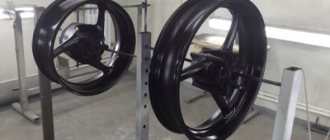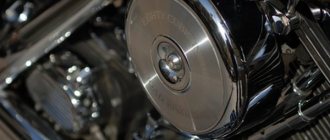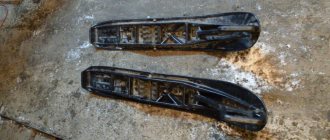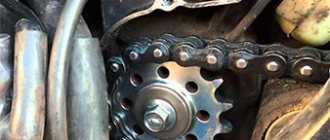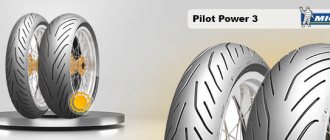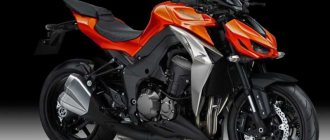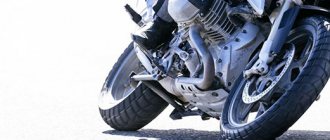- Home /
- Blog /
- Preserving a motorcycle for the winter
Share with your friends
Preserving a motorcycle means preparing it for long-term storage during the winter season. It is necessary in order to preserve the operational qualities of the vehicle, which may change negatively during long periods of inactivity.
Each motorcycle has unique technical characteristics and design features. Therefore, many recommendations may not apply to a specific vehicle. However, this article will indicate the main points that are relevant for any motorcycle.
Seasonal motorcycle storage
From 990 rub./month. More details
Why you shouldn’t neglect winter preservation
Because we all want to ride in the spring, and not repair and repaint our “wheels”. The worse the bike is protected from water (snow or condensation), dirt, direct contact with ice and low temperatures, the worse it will look in the spring, and the more consumables it will require to replace.
By leaving a bike on the street without preparation and without supervision during the winter, you run the risk of “getting” the capital or being left without “wheels” altogether, and in the spring, a normally preserved motorcycle is enough to wash, pump up the wheels and refuel.
Necessary measures
- Pre-wash and dry. After the motorcycle is washed, it is necessary to thoroughly wipe it with a rag and blow out the electrical connectors and all connections with compressed air.
- An oil change is necessary to ensure that the internal metal surfaces of the engine are not damaged by acid emissions that appear during the combustion process.
- There should be some fresh fuel mixed with stabilizer in the tank.
- The cylinders also need to be lubricated to prevent rust. Gasoline is a solvent; before cranking the starter, turn off the fuel and distribute the oil evenly among the cylinders.
- Remove the battery.
- Spray the frame, engine and other metal surfaces with a protective preservative liquid. It protects transport from moisture and temperature influences.
- Tires must be properly inflated.
- Spray the ends of the muffler and drain holes with WD-40.
All these actions are necessary if you want to “sit down and go” in the spring, and not bother with repairs for another couple of months.
Preparing a motorcycle for winter storage
The order of work depends on one more main aspect: are you planning winter repairs (preventive or capital)? If yes - except for washing, drying and removing the battery, there is no point in doing anything - you will still disassemble it.
Preserving a motorcycle for the winter is isolating the motorcycle from potential dangerous influences, including from the owner’s attacks of “mototoxicosis”, such as spontaneous rides in the thaw in January, otherwise there is no point in it. Everything that the motorcycle attached to itself during the outing will need to be washed off again, then the motorcycle will be serviced again and protection will be applied, or corrosion will “work” on it.
If winter operation is expected, the motor is not “mothballed”, but only serviced taking into account the specifics of the season.
Availability of gasoline in the gas tank
The metal gas tank must be filled up to the neck for the winter. This is done to prevent corrosion on the walls of the vessel. It can clog carbs and jets, which will negatively affect the technical condition of the motorcycle. It is also recommended to add a special stabilizer that will prevent the fuel from breaking down into fractions. But if “92nd” gasoline is used, then this is not necessary.
The plastic gas tank does not need to be filled in for the winter, as it does not corrode. For this reason, they are becoming increasingly popular among motorcycle manufacturers.
Conservation for the lazy (mandatory minimum): procedure
If the bike is in good working order and just needs to be covered until spring, a minimum of operations will be enough. They need to be done in the given order: go and fill it up, wash it clean, dry it well, protect it.
Refueling
An incomplete metal gas tank in the cold will inevitably collect condensation inside itself, which will slowly turn its walls into rusty “flakes”. As long as the inner surface of the tank is free of visible corrosion, the process will proceed more slowly. When the tank is already uniformly red from the inside, it’s faster. Also, the larger the evaporation area, the faster gasoline will lose light fractions, reducing its octane number.
What to do to prevent this:
- Drain the gasoline and dry the tank thoroughly. Store it with the neck tightly closed - it will help if it is very rusty.
- Fill until full, draining the residue from the carburetor (if the power system is not injection) - the best option, but not for a living room.
- Leaving as much as you have inside, simply sealing the neck, is not a recommended option: gasoline is toxic and a fire hazard. But, subject to safety precautions, it can be used even in an apartment (the smell of gasoline disappears after a week).
If the motorcycle is stored in the cold (outdoors, indoor parking, in a garage without heating), you must fill the gas tank to the top.
The plastic tank does not require special manipulations. Just remember to close the faucet.
Washing and drying
Proper winterization of your motorcycle includes washing it more thoroughly than usual.
Important points:
- It is advisable to wash only at above-zero temperatures, or to arrange for thorough forced drying.
- Do not forcefully clean the paintwork, and do not wash or dry your motorcycle with old clothing, rags with buttons or rivets.
- In hard-to-reach places, a long-bristled brush will help.
- Keep a very dirty motorcycle under foam (shampoo) for a longer time; if possible, soap it twice.
- For stubborn stains, use bitumen stain cleaner or carb cleaner.
- In addition to external drying, you must warm up the engine by letting it run at medium (not idle) speed for 5 minutes.
- Do not wash the chain, brakes, exposed parts of electrical equipment and the throttle assembly with high-pressure washers!
Care for the seat according to the material. Leather - do not wash with plenty of water, it is better to remove dirt with wet wipes, and then treat with car interior conditioner.
If the seat gets very wet, remove it and dry it at home, warm. But not near the heater - so as not to warp it.
Tire pressure
Even when idle, the wheels slowly deflate, so if the motorcycle is stored on a side stand, it is necessary to inflate the tires 1–1.5 atmospheres above the operating pressure. If the bike will be standing on a trolley or stand, with the wheels hanging out, lower them by 0.5 atmospheres. If you plan to periodically come and roll the bike so that the rubber does not deform, do not change the inflation.
Battery
Any battery for motorcycles, no matter whether it is acid, gel, or AGM, requires storage at above-zero temperatures. It must be taken from a cold box or from the street into a warm room, fully charged and placed in a dry place where neither children nor pets can reach it. Preventatively check the charge every 1–2 months; if it drops below 11.5 volts, charge it.
Simply leaving the battery on the motorcycle with the negative terminal removed (if it is kept warm) is possible, but batteries, regardless of type and brand, are prone to self-discharge after a certain time. An older, more sulfated battery with a less dense electrolyte will discharge faster, within a couple of weeks. Relatively new - will last two to three months. But “it will last” is conditional. The battery is considered “live” if its charge has not dropped below 10.5 volts. Anything below is a deep discharge. If the voltage drops to 8.5 volts - not every battery from such a discharge will be restored - you will have to buy a new one.
Protection of paintwork, chrome, rubber
Painted, plastic, metal chrome parts and even motorcycle optics can be coated with any regular car wax (liquid polish for manual application or spray).
Rubber can be:
- Blacken (with blackening compound).
- Spray with silicone spray.
- Cover with foam that prevents drying out.
Any of these products can only be applied to the beads of tires. The working (central) part is not covered with anything - otherwise, until the top (impregnated) layer of rubber is erased, there will be no normal brakes.
Rodent repellent
Small pests happily gnaw on plastic and motorcycle wiring that is inedible for us. They can devour the casing of wires, gut the seat, making a nest out of it, gnaw off silicone grips and generally anything else they deem necessary.
The poisoned bait must be placed not on the mote itself, but not far from it. Better - on the floor, about a meter away. A special repellent spray - on the contrary, must be applied directly to plastic parts, handles, footrests and wire braiding.
Protective case
For long-term storage, you cannot use windproof fabrics or plastic film, so use a special motorcycle cover of the appropriate size and cut. In the HYPERLOOK catalog you can choose suitable enduro covers, “wrappers” for sports tourists, tourers and classics of different sizes.
When leaving the bike outside, do not wrap it completely - always make a hole at the bottom for ventilation. Indoors - do not tie the cover, but simply throw it over it, to protect it from dust.
Engine and gearbox oil
When preparing your motorcycle for winter, look at the manual and service book - if the oil needs to be changed in the next 300–500 km, it is better to do this before storing it. If maintenance is still a long way off, or winter repairs are planned, don’t change it. The internal combustion engine and transmission need to be serviced according to the regulations, the rest is unnecessary expenses.
Brake fluid and antifreeze
When a cold “hibernation” is planned outdoors or indoors, where the temperature drops to a serious minus, it is advisable to replace the old antifreeze with a new, denser one before preservation. Especially if it was replaced quite a long time ago and the next deadline is approaching.
Brake fluid is more hygroscopic than gasoline, so during cold weather it can “pick up” water. The tank needs to be filled under the cap, just like a gas tank. In the spring, be sure to remove the excess with a syringe. There is no need to change the brake fluid in the fall. It is better to do this before the spring departure.
What problems are possible if conservation is neglected or carried out incorrectly?
If you do not protect motor parts (mirror, bearings, fingers) from contact with moist air, they will rust. This means a less smooth surface, difficult movement due to deformation, noisy engine operation and higher fuel consumption.
Corrosion also does not benefit other parts of the motorcycle. Rust that forms on the inside walls of a metal gas tank will flake off, contaminating the gasoline and damaging parts it comes into contact with.
Contaminants that are not removed in a timely manner create favorable conditions for the development of corrosion under their layer, and after wintering it is almost impossible to remove them.
Fractions contained in dirty oil can clog channels over the winter, and exhaust gas bubbles can cause corrosion. If the battery is completely discharged, it will no longer be usable.
In very severe frosts there is a risk that the housing will crack. Parts not treated with lubricant may become stuck to each other during a period of inactivity. If you do not unload the tires, they will become deformed, since the load is constantly placed on the same area.
Over the winter, paintwork can peel off, leatherette and rubber can crack. If you cover the motorcycle with polyethylene rather than a fabric cover, it will stick to the body and damage the paint, and if the cover completely covers the motorcycle, condensation will accumulate under it. If the rules of preservation after wintering are not followed, both the performance characteristics and the appearance of the motorcycle will suffer.
Extended motorcycle care before winter storage
Complete preservation of a motorcycle for a long period of time (not only in winter) involves more careful attention to detail than regular washing, and protection with the appropriate class of products.
The lines of car and motorcycle cosmetics are not fundamentally different. Products from one and another brand (manufacturer) are also within the same group, so choose consumables for detailing based on availability and budget. The minimum you need is a gentle paint-friendly cleaner and a hand polish.
Filling into cylinders
In order to prevent oxidation, it is necessary to unscrew the spark plugs and drop a few drops of engine oil directly into the cylinders. It is recommended to do this for the gas tank as well. This rule applies to all motorcycle storage conditions, even dry and warm rooms.
Protection of the body and paintwork
The motorcycle must be clean before storage. This is necessary to preserve the paintwork and prevent its destruction due to dirt. Next, it is recommended to cover the surface of the motorcycle with liquid polish or silicone grease. They form a dense protective film that will protect the paintwork from the negative effects of moisture.
Materials and tools you will need to preserve your bike
Preparing for parking may require some troubleshooting, so keep a tool kit handy. You will need: a cover, cleaners, chain lubricant (if the motor is a chain), a pump (compressor), a pressure gauge, napkins and microfiber, “cosmetics”, possibly oil and gasoline for topping up.
As for technical means, for installation indoors it is recommended to acquire a motorized tackle and blocking brackets. When rolling, the bike will be protected from falling, the load on the tires will be less, especially if there is no central stand, but only a side one.
Protective case
Its presence is not required.
If the garage does not have a high-quality ventilation system, then, on the contrary, the cover can cause harm. The resulting condensate will not be able to evaporate, and it will accumulate under the canvas. This will cause rust to form. If there is high humidity in the room, then you cannot cover the motorcycle with a cover. To summarize, all of the above tips are general in nature. Once again I would like to repeat that each vehicle is unique. Therefore, you should familiarize yourself with the official recommendations from the manufacturer. They can often be found directly on the company's main website.
Or you can use the professional storage service for motorcycles for the winter. Our company MOTOSAVE invites you to park your motorcycle in an equipped parking lot. We will independently prepare the equipment for wintering, taking into account all the above recommendations. Our company works under a contract and guarantees the safety of your vehicle.
The need to put your motorcycles in winter storage. How to properly prepare a motorcycle for winter?
Stages of motorcycle preservation
The basic rule of high-quality motorcycle care is to know why and with what frequency a certain manipulation is carried out for your specific device. What is vitally necessary for him, including from the “preservation and storage” section, will be printed by the manufacturer in the user manual. Be sure to download the manual for your bike and check it. The rest is from the category of desirable, but optional procedures.
Service
After washing the motor, inspect it for chips of paint, obvious wear of parts, and gaps that need to be eliminated. If the time is right, change the oil. There is no need to change the fuel and air filters, it is better to do this at the beginning of the season, but if the “air” is serviceable, it will be practical to clean its body from the inside and shake out large debris from the folds of the cassette.
Candles. If during operation the ignition system worked without any problems, do not touch the spark plugs. Moreover, if the engine is “watery”, in which, in order to get to the head, you need to disassemble the cooling system and remove half of the lining.
For the winter, you can treat the spark plug insulators, caps (on top) and armored wires with silicone compound - a hydrophobic dielectric paste. If necessary, they can be unscrewed, inspected, checked for spark quality, the defective one or the entire set can be replaced and screwed back in, observing the required tightening torque.
Chassis
The cardan final drive is usually closed and only requires checking (sometimes topping up) the transmission oil.
The chain needs to be washed and re-lubricated before winter. To clean, use either a special spray or diesel fuel (diesel fuel) and a soft brush. Do not use gasoline or aggressive solvents! For lubrication, use a product appropriate for the type of motorcycle: sports lubricant is not suitable for treating an endurik chain, and vice versa!
Belt – does not require special maintenance. Only periodic cleaning, checking for sagging and alignment of the pulleys.
Electrical equipment
The need to remove the battery has already been discussed. This is an indispensable part of conservation, regardless of the parking location. Even when preparing for winter storage in unfavorable conditions, it is recommended to treat all wiring, switch housings and steering wheel controls with a “liquid insulator” that displaces moisture. The main connectors are to open, spray with “contact cleaner” (this is a different product), dry and reassemble.
Tank and fuel equipment
Nowadays there are several types of gasoline additives on sale: cleaning agents, octane correctors, drying agents and ash content reducers. If you have no choice but to store your motorcycle in a cold garage in winter, adding an octane corrector to the tank will help keep the fuel in good condition. But only if it was initially without water and of good quality, so don’t skimp and fill it up at a proven gas station.
You can do without additives by refueling with higher octane fuel. If you ride on the 92nd, use the 98th, in a few months its characteristics will “get closer” to the required ones.
In the spring, before starting the engine for the first time, it is advisable to disconnect the fuel line and drain about a liter of what settles in the gasoline below, adding fresh gasoline instead, or drain all the gasoline from the tank into a canister and fill in a new one, and periodically add “winter” gasoline by “rolling out” it in portions.
On carburetor models, before preservation, it is recommended to drain the sediment from the float chamber. For injectors, if possible, before “hibernation” the throttle assembly (spray), injectors and valves (fuel additive) are cleaned.
Advice on additives
Regardless of whether it is in gasoline or oil, it is advisable to add additives only one at a time to avoid possible undesirable reactions. Combining products is only possible if expressly indicated by the manufacturer.
Do not exceed the indicated dosage. If the tank has a capacity of 14 liters, and the additive bottle is designed for 30 liters, do not pour it all out. The mixture will not work more effectively. An overdose of metal-based desiccants increases the ash content of the exhaust and provokes carbon deposits, and exceeding the content of octane correctors significantly increases the combustion temperature of the fuel mixture. This can cause cylinder head overheating or thermal seizures.
The advertising effect of additives should not be overestimated. They help keep the engine or transmission in its current condition longer, but cannot compensate for severe wear or corrosion damage. Their use is justified on “fresh” motorcycles, but on seasoned 20-year-old “horses” the effect may not even be noticed.
The above tips are also relevant for owners of scooters and snowmobiles (the former need to be prepared for hibernation for the winter, and the latter for summer storage). The same applies to all-season ATVs if they are used only in the warm season.
Before storing your motorcycle, make sure it is in a safe, dry, ventilated place. We will talk about the options available to motorcyclists in Moscow and other large cities in the next article.
Preserving the engine for the winter
As mentioned above, the engine itself and the engine compartment need to be washed. This can be done in different ways, from dry engine washing to steam or Karcher pressure washing.
Then the engine and engine compartment must be thoroughly dried. As for the external treatment of the internal combustion engine, you can use a spray to preserve the engine and engine compartment. In fact, this product resembles varnish, but has an anti-corrosion effect and also repels dust. Similar compositions are available in the catalogs of various domestic and foreign manufacturers of auto chemicals.
Now let's look at engine preservation from the inside. If the parking is not particularly long (up to 6 months), then the main task is to avoid corrosion in the cylinders. To do this, pour in 40-50 grams of clean motor oil. This can be done through spark plug wells on gasoline units and through glow plug wells on diesel engines. Even after filling the oil, you need to crank the crankshaft 2-3 times. This method will prevent piston rings from sticking and corrosion in the engine cylinders.
You can also pay attention to ready-made professional solutions. For example, you can fill in a special oil to preserve the engine or use special lubricants
Car enthusiasts often use aerosol lubricants that contain anti-corrosion additives. Such lubricants have high adhesive properties and are designed specifically for preserving the internal parts of engines, both gasoline and diesel.
Also, all drive belts (alternator belt, timing belt, etc.) should be slightly loosened or completely removed from the internal combustion engine for storage in a heated room. This will avoid cracking and reduce the load on the drive elements.
Note that to store a car for 3-4 months, such engine preservation is not always necessary, since problems do not appear often after such downtime. Moreover, if the car is planned to be delivered for 8-9 months or more, the above procedures must be carried out.
Article on the topic: The engine oil has turned black: why does this happen?
We also recommend reading the article on how to properly store your car battery. From this article you will learn about the features, nuances and recommendations regarding battery storage.
Moreover, in both the first and second cases, it is important to take into account that if the car is parked in an unheated room in winter, then any liquids that can freeze must be drained. We are talking about antifreeze or water in the cooling system, etc.
Where is the best place to store a motorcycle?
Friends will say - a garage (yup, unheated), the mother-in-law will suggest a shed in the country, the wife will advise sending the bike to a paid parking lot, but all this is not the same. The best place to store a motorcycle in winter is a warm Attic storage area. Why are we so sure of this? Look at the benefits of winter motorcycle storage in a warm warehouse:
Attic movers will come straight to your home and take your motorcycle to the warehouse, where it will be safely stored all winter. When the season comes, we will bring it back to anywhere in Moscow. All motorcycles in the Attic are stored in a separate area on pallets - we keep them warm, dry and happy.
Warm motorcycle storage in winter is the best thing that can happen to your bike
Seasonal storage of motorcycles is almost a ritual that must be carried out according to all sacred biker canons. How your iron friend spends the winter will greatly affect how it rides in the summer. If you don’t change the oil in the engine, it will answer you with an unkind cough in the spring. If you miss an oxidized contact in the wiring, expect sparkling light music throughout the motorcycle, which is unlikely to want to go anywhere in this condition. And the most expensive price you will pay is your spoiled mood at the very beginning of the season, when you see that the motorcycle is “no longer the same.” In other words, every little detail matters. Prepare your bike for winter storage so that in spring you'll be blowing away with the wind as soon as you step on the throttle. Fair wind!
Source
